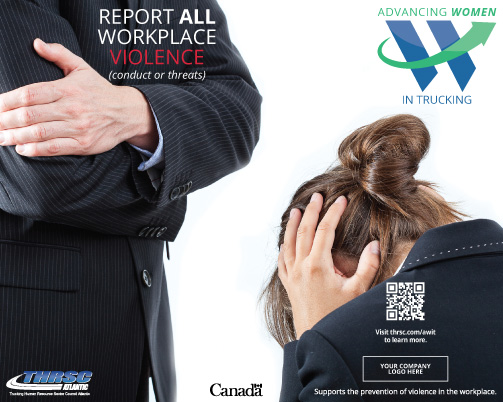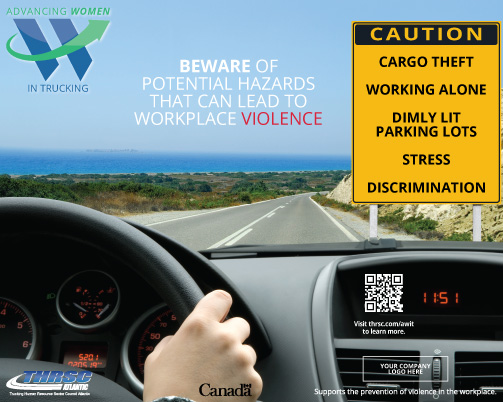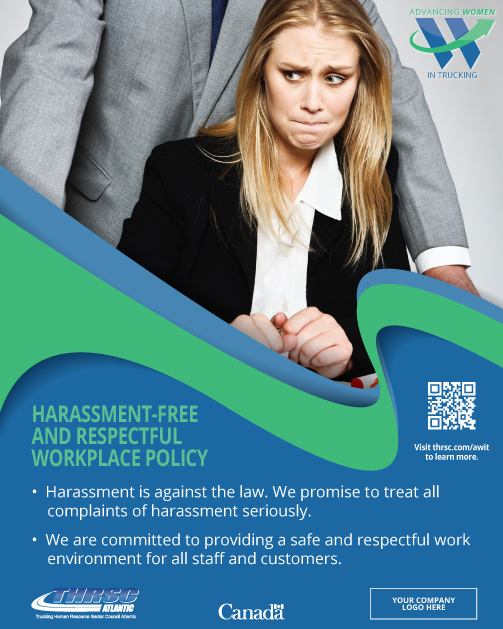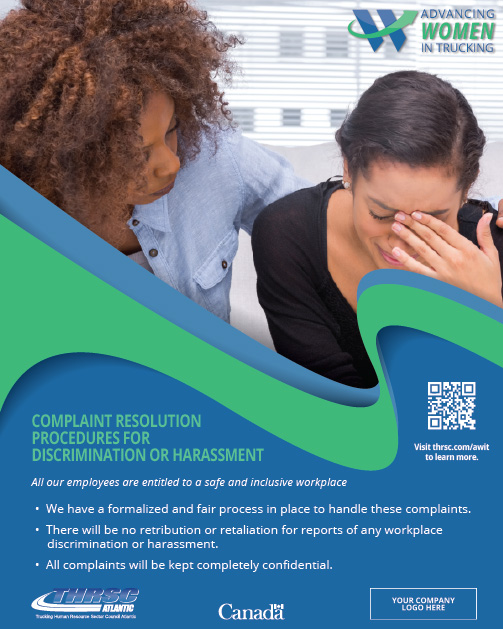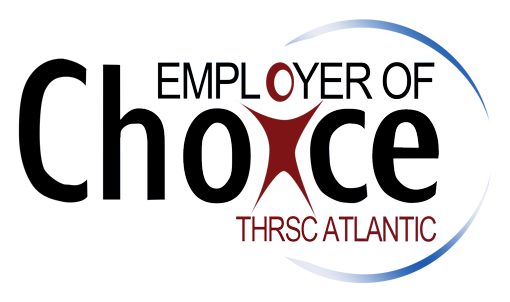Retention
Promote a Gender Diverse Culture
Keep in mind that just because you are open to more women in trucking does not mean that everyone in your organization has the same mindset. The reality is that the trucking industry has traditionally been and continues to be male-dominate. While the majority of men in trucking welcome women and are advocates for their advancement, there are some biases that do remain and discrimination does occur. As a leader in your company, it is your responsibility to develop the cultural direction you wish your company to take. You must set the framework so that a culture of diversity and inclusion can exist. Wanting it will not make it happen. Creating a culture of inclusion takes real effort and strategic planning.

Below are some steps you can take to ensure your workplace is not only welcoming to women but a place they can feel safe to reach their full potential.
Commitment from the Top
A critical part to ensuring the success of any business initiative or strategy is having commitment from the top. Senior managers need to be committed to the creating an inclusive culture for women in trucking because it is the right thing to do. Need convincing? Check out: Making the Case.
Once a commitment has been solidified, an inclusive culture for women in trucking needs to be a part of the company’s overall vision, mission and strategic direction. Remember it is not just enough to diversify your workforce. You need to ensure that you foster a culture of inclusion that will ensure the long-term retention of women as well. To achieve this consider the following steps:
Conduct a meeting of senior executives and other managers to get input and buy-in or introduce the topic in a regularly scheduled meeting.
Set your strategic goal so that it is specific and measurable and ensure that timelines are set. This will allow you to monitor its progress during the implementation phase to ensure success.
I have been in the trucking industry for over 30 years and am pleased to see today more women are choosing careers in trucking. Whether in the field or at the boardroom table, they have raised the bar of excellence. Trucking needs more women.
CREATING A COMMITTEE

Congratulations! If you have made it to this portion of the toolkit you have shown a real interest in not just attracting women to trucking but to making your workplace more welcoming as well.
As we have seen under the section Commitment from the Top the first step to creating a welcoming workplace for women is to ensure it aligns with your overall company mission, vision and strategic direction. The next step is to develop a plan for achievement.
One of the most effective ways for you to create an inclusive culture for women in trucking is to establish a committee of employees who can offer valuable input and feedback. Getting employees involved will also help to ensure buy-in. Take some time to consider the Committee’s purpose and create its terms of reference.
Terms of Reference Sample
NOTE:
SUGGESTION:
One of the deliverables of your committee should undertake is to gather all company documentation (including recruitment and training materials as well as policies and procedures) and check it for gender inclusive language and content. A good resource to complete this can be found on the Government of Canada website under the Language Portal entitled Guidelines for gender-neutral language at http://www.noslangues-ourlanguages.gc.ca/bien-well/fra-eng/style/nonsexistguidelines-eng.html
ANOTHER SUGGESTION:
Have your committee complete an assessment of your workplace to determine its gender inclusive condition. A great guideline for this audit can be found on pages 14 and 15 in a document created for the Federal/Provincial/Territorial Ministers Responsible for the Status of Women by Denise McLean. Workplaces that Work: Creating a Workplace Culture that Attracts, Retains and Promotes Women. (2013) Retrieved from www.gov.pe.ca
Sources:
- Denise McLean. Workplaces that Work: Creating a Workplace Culture that Attracts, Retains and Promotes Women. (2013)
Retrieved from http://www.gov.pe.ca/photos/original/iws_workplaces.pdf- Terms of Reference Template.
Retrieved from http://novascotia.ca/psc/pdf/employeeCentre/recognition/toolkit/step2/Terms_of_Reference_Template.pdf
Provide a Safe and Inclusive Environment
As an employer operating in Canada, you must take all reasonable precautions to protect the health and safety of ALL your employees. This is not only a legal requirement; it is also the right thing to do. As you try and increase your representation of women, you must also provide a work environment for them that is gender inclusive, respectful and harassment-free. Although there are challenges and obstacles women face in male-dominated industries that are unique to them, the development of a safe and welcoming environment will benefit all employees.
One of the first steps to creating a safe and healthy environment is commitment from the top. This is best communicated to employees through the creation of written policies and programs. Below are just a few of the policies that you should have to ensure that you provide a safe and inclusive workplace for all employees inclusive of women.

Prevention of Violence in the Workplace

In the trucking industry the threat of violence is real for any employee. Workplace violence is the threat of or act of violence against an employee while engaged in work related activities. The threat can arise from a supervisor/manager, fellow employee or outside source such as clients, vendors, personal acquaintances, or other third party sources. It can result from a dispute, stress factors, or other personal or job-related factors. The risk increases for those who travel, work off-site, or who have a mobile workplace. For Professional Truck Drivers and Yard Personnel, this threat is heighted by cargo theft, which is reportedly one of the most lucrative crimes in Canada. Such activities can lead to violent encounters.
FACT:
Truck drivers can be victims of either physical violence or verbal abuse. Among 300 Australian truck drivers surveyed, 30% had been victims of verbal abuse, 21% had been victims of “road rage,” 10% had been threatened, and 1% had been assaulted.
Retrieved from wwwdocs.fce.unsw.edu.au
FACT:
In a survey conducted by the THRSC Atlantic on Women in Trucking, the majority of women who cited Safety as a major concern in their jobs were women drivers and those that traveled alone for work.
In order to offer a safe environment for all workers employers in Canada should have a violence prevention program that protects their employees. This program should include an assessment of all your employees and those who are more at risk. Unfortunately, women who travel, work off-site or have a mobile workplace can be seen as more vulnerable to criminals such as thieves and sexual predators. As the representation of women increase in the trucking industry, this increased risk factor must be considered when you establish and/or update your violence prevention program.
In creating a Violence Prevention Program, you should:
Conduct a workplace violence hazard assessment and be sure to include all occupations and/or departments
Develop safe work practices and prevention measures for all employees at risk.
Create written policy to set the guiding framework of what workplace violence is and how it will be dealt with in your organization
Create and implement a formal training and awareness plan targeting managers/supervisors and employees.
Establish an emergency response plan for a serious incident
Establish reporting and investigation procedures for violence prevention
Provide support (For example through EAP programs) and accommodations to victims
Conduct follow-up on incidents
Conduct an overall program review on a periodical and consistent basis
REMEMBER, IF YOU BUILD IT, SHE WILL COME!
IDEA:
Creating awareness of potential violence in the workplace can aid in its prevention. Download these posters that you can use in your office to create awareness surrounding violence in the workplace.
Also check out this resource from the Canadian Center for Occupational Health and Safety at http://www.ccohs.ca/products/publications/violence.html
For legal information for federally regulated employers, see: https://laws-lois.justice.gc.ca/eng/regulations/SOR-2020-130/index.html
Harassment-Free and Respectful Workplace Policy

In Canada there are human rights laws that protect employees from harassment. As an employer you are required to ensure you provide a harassment-free environment for your employees. You need to be aware that you can be held legally responsible for harassment in your workplace regardless whether you were directly involved. Developing and implementing a harassment-free and respectful workplace policy can help fulfill your requirements and protect everyone in your company. The purpose for creating a harassment-free, anti-harassment or respectful workplace policy is to proactively foster a positive work environment that does not tolerate discrimination or harassment.
Sexual harassment is a form of harassment that does occur in the workplace and is more prevalent in male-dominated organizations. (David Langtry. (2012). Address to the Standing Committee on the Status of Women. (Speakers notes) Retrieved from www.chrc-ccdp.gc.ca) Sexual harassment is not just about unwanted contact of a sexual nature. It is also any conduct, comment, or gesture that is likely to cause offence or humiliation.
As an employer in a male-dominated industry committed to increasing the representation of women, it is important that you are aware of these issues and take every measure to prevent harassment in the workplace. Be sure to include an explanation of sexual harassment in your policy.
Harassment Policy Poster:
The Criminal Code of Canada further protects all people from physical or sexual harassment.
- 3 in 10 Canadians say they have been sexually assaulted (28% of the Canadian workforce) 28%
- 43% of Canadian women have been harassed in the workplace 43%
- 12% of Canadian men have been harassed in the workplace 12%
- 80% of sexual harassment incidents at work have gone unreported. 80%
Working Alone Policy
One of the preventative measures you can develop in your Violence Prevention Program to ensure the safety of all employees is to create and implement a Working Alone Policy. However, keep in mind that violence is not the only thing that can occur to an employee who is working alone. An injury or sudden illness that requires immediate assistance is also a risk of working alone.
If you have employees working alone, it is important that you identify the hazards associated with working alone for all your employees, including women, and then put controls in place to eliminate or minimize the risks.
Here are some things to consider when developing your Working Alone Policy:

When identifying who works alone, consider not only your mobile and off-site employees, also take into account employees who are isolated from other employees throughout the day and those who work alone on shifts at your place of business.
Ensure all employees have access to emergency numbers as well as first aid and emergency supplies.
Develop an employee tracking and check-in procedure for employees at risk (This may include a shift sign-in and sign-out plan).
Ensure employees at risk are aware of the potential hazards when completing their tasks while alone and have been trained to the safe work practices and procedures for their job.
Ensure any equipment is being used to manufacturer’s specifications and is well maintained.
Review the layout of your place of business with particular attention to where employees work during the day and their contact with other employees.
Review your building structures and parking lot for visibility and lighting and eliminate or reduce hazards that may exist for employees working alone. (For example a dimly lit parking lot late at night can create potential for injury or violence)
When possible create a buddy system to avoid “working alone” scenarios.
Further resources can be found at :
http://www.ccohs.ca/oshanswers/hsprograms/workingalone.html
http://www.worksafebc.com/publications/health_and_safety/by_topic/assets/pdf/bk131.pdf
Complaint Resolution Procedures for Discrimination or Harassment

One of the most significant ways you as an employer can retain women in trucking is to provide a harassment-free and respectful workplace. A safe and inclusive workplace for women in trucking must include the encouragement of all employees to file reports of any workplace discrimination or harassment without fear of retribution. This not only takes power away from the harasser, it also gives you, the employer, the opportunity to lead your company into a positive cultural direction free of sexual discrimination and harassment.
It is not enough that employees report incidents of discrimination and harassment such as sexual harassment. As the employer, it is your obligation to ensure that you have a formalized process in place to handle these complaints. This process should include an investigation procedure as well as what disciplinary action will be taken against the alleged harasser if found guilty. Also keep in mind that if the complainant of the harassment fears for her safety or the safety of others, she should be encouraged to report the incident to law enforcement in her area.
Here are some things to consider when you develop and/or review your existing complaint resolution procedures for harassment and discrimination:
Ensure a clear and well-communicated reporting process is in place and it is noted that retaliation for filing will not be tolerated. (Tip: Include more than one person in your complaint reporting process)
Supervisors/managers and employees are trained on your complaint procedures
Commit to choosing a competent person/group is to conduct an investigation who is informed of human rights issues and who is without bias.
Ensure an investigation is conducted promptly
- Interview all parties (including the complainant, the alleged harasser, and any witnesses)
- Ensure a safe environment is provided for all (may include allowing the interviewee to bring representation)
- Take into account all evidence (electronic and written)
- Ensure all aspects of the investigation is documented
Maintain confidentiality throughout the process
Ensure a written report is prepared with findings and recommendations
Communicate findings to both the complainant and alleged harasser.
Ensure the complainant is aware if they are not satisfied with the findings they have a right to file a complaint with the human rights commission in the jurisdiction under which your company is regulated.
For more information:
Visit the Canadian Human Rights Commission website under the tab Organizations and Businesses at
http://www.chrc-ccdp.gc.ca/eng/content/how-develop-internal-dispute-resolution-process

Complaint Resolution Poster:
Flexible Work Options

Randstad Award research reveals that women are more driven by pleasant working environments, convenient locations and flexible work options. It also notes that they want career success without making major sacrifices in their personal and family lives. This can ultimately determine their employment choices. (Tanta de Decker’s article, “Winning hearts and minds: what female professionals look for in a future employer.” (Aug 2015) Randstad Sourceright. Retrieved from http://insights.randstadsourceright.com/h/i/147857428-winning-hearts-and-minds-what-female-professionals-look-for-in-a-future-employer)
Are there jobs in your company that can offer flexible work options? A recent survey on women in trucking (Retrieved from http://ontruck.org/survey-women-in-trucking-satisfied-with-their-jobs/) reveals that a flexible work option was one of the three top things the industry could do to be more attractive to women. Traditionally companies have shied away from this as people often think that this shows less commitment to the workplace. The fact is, however, that in today’s workforce, a flexible work option can increase productivity and commitment by offering a better work-life balance and less stress in the workplace. The challenge in offering flexible work options will be how to manage expectations and ensure results are delivered within the parameters set. This will require proper planning and monitoring.
- Flexible work shifts (for example 4 days on and 4 days off). For Truck Drivers for example this would require sharing trucks and perhaps cutting the runs into pieces)
- Flexible work hours to accommodate personal/family obligations.
- Work-sharing
- Part-time
- Ability to work from home
For further information on Flexible Work Options visit https://www.ccohs.ca/oshanswers/psychosocial/flexible.html
Develop and implement training and policies that support diversity
Women in Trucking Diversity Training
A diversity-training plan is one approach that can increase the inclusiveness of women in trucking. It can create both awareness and foster communication in the workplace. Men have long dominated our industry and in many cases an “old boy’s club” can still linger even when not intended. The fact remains that over 85% of employees in our industry are male. Out of fear not to discriminate or offend, some men feel uncomfortable or guarded around women colleagues. Others may resist diversity in the workplace and feel as though they are being smothered in political correctness. The fact remains that a workplace has a set of appropriate standards for behaviour that must be followed in order not to hurt or offend. Providing an environment that is free of discrimination is not only the right thing to do, it is your legal obligation as an employer.
Training may not change someone’s beliefs but it can make him or her more aware and accepting of gender differences and issues. It can also help provide a better work environment for all.
%
of employees in our industry are male
A diversity-training plan that includes gender diversity should be incorporated in:
- Employee Orientation
- Supervisor/Manager Training
- Ongoing Employee Training and Meetings
in your diversity training plan or use it as a template to create your own.

Measuring Your Success
In order to retain women in trucking, you as an employer, need to increase female engagement and satisfaction in their work and your company. Investing into the development and implementation of various employee programs that appeal to women in trucking can help make this a reality. Keep in mind that many of the initiatives you undertake to increase the retention of women will also increase the retention of all employees. Diversity committees, flexible work schedules, and providing a safe and inclusive work environment is just a few of the many things you can do. As with any business strategy, however, you will need to monitor and evaluate any approach you use to ensure your efforts are yielding success. Employee policies, programs or initiatives that are archaic or irrelevant may be counter-productive, regardless of its intent.
There are many measurement tools an employer can use to monitor and evaluate female employee satisfaction such as:
Employee feedback forms
Department meetings
Suggestion boxes

Surveys
Surveying your employees is a great way to obtain relevant and useful data for you to evaluate employee satisfaction with you as an employer. Asking questions about gender inclusion can provide some valuable insight. Surveying current employees, as opposed to just giving feedback from departing employees in exit interviews will not only give you an opportunity to evaluate your company’s performance as a quality employer, it gives you an opportunity to address any issues before losing valuable employees.
THOUGHT:
Struggling with the time and resources to develop and implement employee surveys? Consider applying for Trucking Human Resource Sector Council Atlantic’s Employer of Choice Program. Employee surveys designed to evaluate its employer on key areas such as its overall culture, programs and practices offer valuable insight to employers with detailed company summary reports.
Exit Interviews
An exit interview is another tool you can use to gain insight into your company’s performance as an employer and evaluate your current programs. With this information you can improve staff retention. Although often criticized for being time consuming and potentially subjective, the exit interview can be an opportunity for you to receive an objective and constructive evaluation if conducted properly. This is because departing employees may be less bound to office politics and more forthcoming with their critique.
Sometimes employers are reluctant to conduct exit interviews because they fear it will highlight an issue they would rather avoid. In order to retain your current female employees and increase your representation you have to know how successful your company is in providing a safe and inclusive environment for women. You need to ask the tough questions to ensure that everyone shares your vision of an inclusive and diverse workforce.
When conducting exit interviews ensure it occurs in a safe environment where the departing employee is encouraged to share her thoughts without fear of leaving her employment on a bad note. Tell her the purpose of the exit interview and encourage her to be candid in her response.
Note: The sample given is generically designed. If your company is trying to understand/evaluate certain programs or issues specifically such as salary, training programs or aspects of culture, add these questions to customize a form that best suits you.
Measuring Retention

Another great way to measure your success retaining women in trucking is to include females as one group of employees you specifically track when you collect data for your retention rate calculations. These rates can give you a picture of how your company is doing with the retention of its female employees in departments as well as company-wide. It can also give you a basis for setting retention targets of women in your organization. These numbers however will not tell you WHY your numbers are as they appear. To achieve this you will need to rely on evaluation tools such as the employee survey or the exit interview.
The basic measure of employee retention is often expressed as turnover. This can be calculated by taking the total number of employees for the reporting period and divide it into the number of employees who that left during the reporting period. Therefore if you have 10 female drivers in total and 2 left during the reporting period you would calculate in the following manner: 2/10 = 0.20 x 100 = 20%. In other words your turnover for female drivers is at 20%.





